Tag Clouds
Files
This work has been commented by 3 curator(s). Read the comments
Title
Tag Clouds
Headline
Turning graffiti hall of fame into tag clouds
Concept author(s)
Mathieu Tremblin
Concept author year(s) of birth
1980
Concept author(s) contribution
Author of concept and realisation, as graffiti writer and as artist.
Concept author(s) Country
France
Friendly Competition
Love Conflict Imagination (2010-2011)
Competition category
Visual communication practice
Competition subcategory
static
Competition field
nonacademic
Competition subfield
artist
Subfield description
I'm acting in urban spaces most of the time. Murals, installations, hijackings which depends to the context. When I have to exhibit it most of times I use polaroids and videos – sometimes hijacked object / tools for themselves. Here is a small text from my portfolio « Mathieu Tremblin implements graphic processes of intervention inspired by anonymous, autonomous and spontaneous practices and expressions in urban space in order to question the systems of legislation, representation and symbolization of the city. »
Check out the Love Conflict Imagination 2010-2011 outlines of Memefest Friendly competition.
Description of idea
Describe your idea and concept of your work in relation to the festival outlines:
Tag Clouds principle is to replace the all-over of graffiti calligraphy by readable translations like the clouds of keywords which can be found on the Internet.
It shows the analogy between physical tag and virtual tag, both in the form (tagged walls compositions look the same as tag clouds), and in substance (like keywords which are markers of net surfing, graffiti are markers of urban drifting).
Since I was a teenager in 1996, and read Norman's Mailer theory and investigation about "the Faith of graffiti", I was always convinced that writing nicknames was more interesting to learn about how unhabitants are living in the city and making it alive – like wild grass.
The power of users, their expertise about territory talks about freedom – urbanity, when the power of city council and expertise of architects projects is about control – urbanism.
All the idea of Tag Clouds came from the envy not to be focused on the decorative part of graffiti – saying like neophyte and authority that simple signatures are visual pollution, and complex colored letters are artistic expressions.
As if tagging the city was about freedom, and drawing decorative letters about control. I wanted to find a project that will turn "ugly tags" into something "beautifull", but conserving the subersive part of langage distorsion.
What kind of communication approach do you use?
This is viral / mimetic communication inspired by graffiti practice. It's related to idea of turning traces of passage from graffiti writers community into something poetic and understandable by everyone. Graffiti writers conserve their presence in a way of pure ego. But the form goes typographic and lose all its alterity – so writers can figure that it's like a kind of institutionalisation of their subersive gesture where their visual noise is rejected by common people – even by me as a kind of cultural smuggler. They could understand this translation gesture as a refusal, as if handmade expression where not allowed to be here, in the city. And in the same time, I'm acting like any graffiti writer, creating something coherent from chaos, as if I was making some kind of artwork with spray cans ordered by the owner who can stand those tags upon his wall. But Tags Clouds is not so decorative, in fact it makes graffiti more intrusive. Ego noises filter directly to readers brain. Like annoying sounds that you hear by walking, it's meaningless in itself, but contextually speaking about city experience and territory reading.
What are in your opinion concrete benefits to the society because of your communication?
Tag Clouds also give access to the content of graffiti nicknames, sometimes meaningless, sometimes poetic. The benefits is about future appreciation of graffiti writing. "Street Art" term seems to have been appropriated by Mass Media in order to tolerate and recognize graphic forms acting like viral marketing. In deed so called "Street Art" is a way for Power to condamned all none artistically recognisable forms of discours in the city. Spontaneous graffiti writing became the ugly duck of art in the city. With Tag Clouds the idea is to make a tribute to spontaneous writing, in order that unhabitants accepts its visual presence by reading it.
What did you personally learn from creating your submitted work?
The funny part of this action is that people generally do not take time to really look to those calligraphy because most of them are influenced by the vision of mass media or city council against graffiti writing. During the translation I realize that people could find interest in reading graffiti calligraphies ; they were curious that someone who didn't look like the image they had of a graffiti writer could read it, pay attention and make them appreciate this urban phenomenon.
I was surprised that they didn't see this operation as something more intrusive or agressive than the real calligraphy, because they were facing to pure ego of writers without artistical part of calligraphy.
But the most interesting reaction is the one from the writers themselves.
On one hand, some of them really appreciate the idea because they didn't felt offensed by my action. They liked the idea that after covering all the hall of fame, people could read still and easily their name instead of the classical decoration graffiti fresco covering those kind of vandal tags.
On the other hand, some of them wrote as if the nicknames translated were not real writers name. They didn't show respect about the basic rules of graffiti practice : don't write over another writer's name.
Why is your work, GOOD communication WORK?
Because it make citizen think and question about a practice which is condamned by society. As anti-graffiti posters said in the early 80's in USA. "Make your mark in society. Not on society."
Tag clouds does both. Make marks ON society appreciate IN society.
Where and how do you intent do implement your work?
Tag Clouds is only meaning something in context.
I just have to find a wall covered with graffiti writing.
Them sometimes I ask the autorisation to the owner, sometimes not.
Did your intervention had an effect on other Media. If yes, describe the effect? (Has other media reported on it- how? Were you able to change other media with your work- how?)
Curators Comments
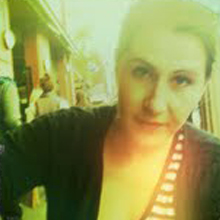
Dr Zoë Sadokierski
This is a witty, thoughtful piece of work. I love the attention to detail in your translation of the original graffiti on ‘Colombier Optique’– staying true to the scale, colour and positioning of each original tag in your replicated version. The link between graffiti tagging on walls and digital tagging on websites is very clever, and makes us rethink why people tag with their nicknames on walls in the first place – marking their territory, or the number times they pass through a particular space.
I’ve always hated the ugliness of many tags, and love this ‘ordered-chaos’ response. Your written rationale clearly explains your thinking about how this project fits the brief, linking power, conflict and love through a sub-cultural art practice that is deeply meaningful to its practitioners, condemned by city councils and sometimes hijacked by advertising/media for it’s ‘cool factor’. The fact that you have talked to other graffiti artists to get their response is fantastic, and it shows a strong-willed visual communication practice to understand both sides of their response – that it is just another version of what’s already being done (but more readable) and that it also breaks the fundamental rule of graffiti practice: don’t write over someone else’s name. I hope you continue to come up with other subversive projects like this, and continue to execute them in such a well-considered and well-designed way.

Jason Grant
I'm interested in this project in spite of being ambiguous about many aspects of it.
I can imagine its success in provoking deeper consideration of public communication generally and graffiti in particular. It has the potential to do what all good radical design should: help people see their world anew.
The stated relationship to keyword clouds is perhaps not visually direct enough. A stronger visual link to the appearance of the tag cloud's internet equivalent by more closely mimicking the clustering of higher density words depicted in a larger sizes might help this conceptual intent. If this link isn't amplified the work risks merely being read as a 'taming' of the feral public landscape.

Tony Credland
An interesting piece of work that challenges our understanding of tags in our everyday environment. As the short film slowly reveals, the actual words written on the shutters are only names and self promotion, not as subversive as graffiti is often portrayed, now portrayed in such a way that these voices are not removed from the streets, but reinterpreted for new audience.
Graffiti has been recuperated into the mainstream discourse, by artists and advertising, where as tagging remains opaque, in a way that it is either ignored or condemned.
I am interested in the formal nature of the final typography, basic and clean, using the same process and texture of the original, also retaining the initial colours used. It is remarks on the authority of a typeface in the environment, and who might have been responsible for the random words that remain.
This work draws our attention to the actual words written, something that is usually hidden in the complex typography of a subculture.The end work raises as many questions as it answers, as we are now forced to think about the way these tags work in a commercial environment, as they now look like they might be part of the surrounding advertising / shop front.

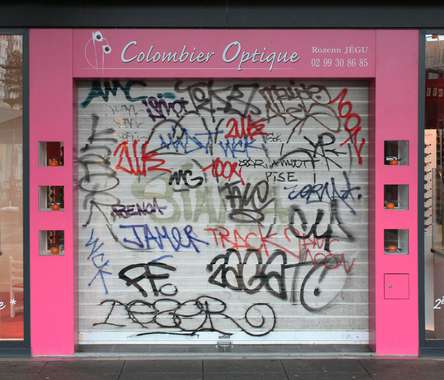
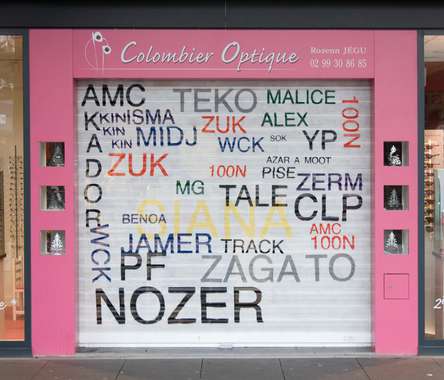
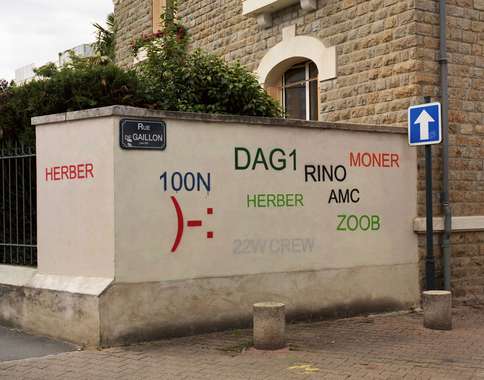
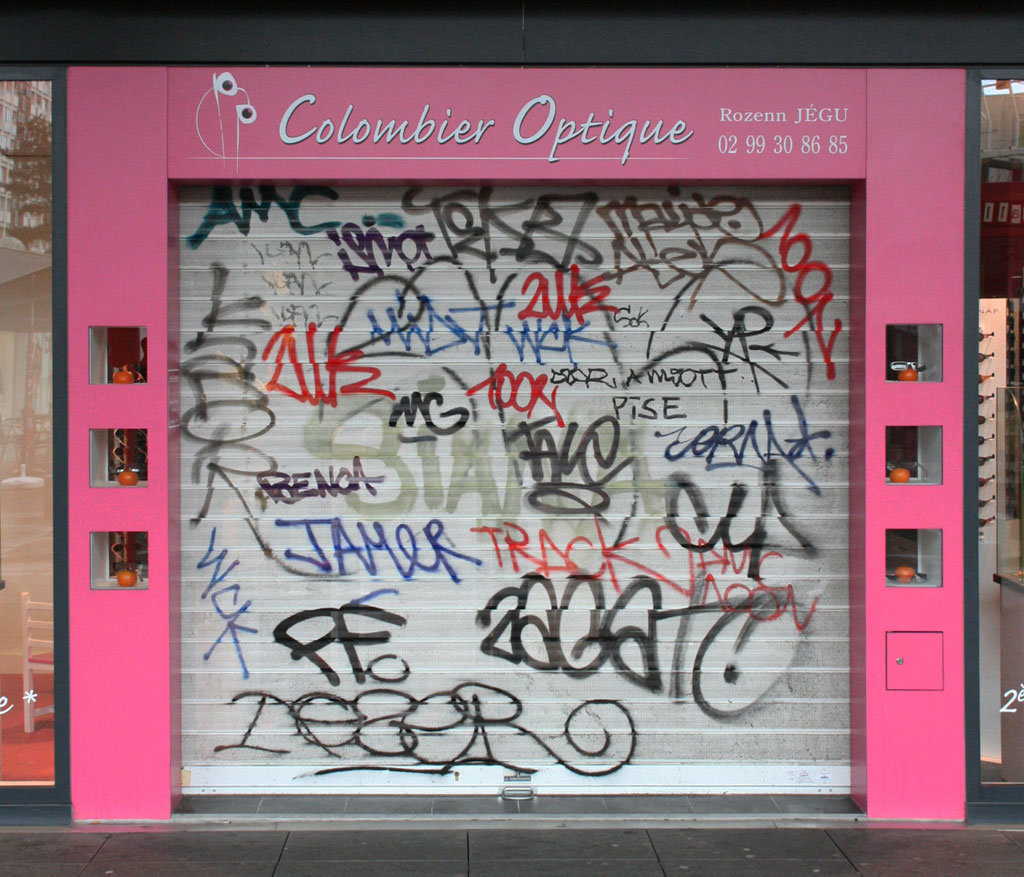
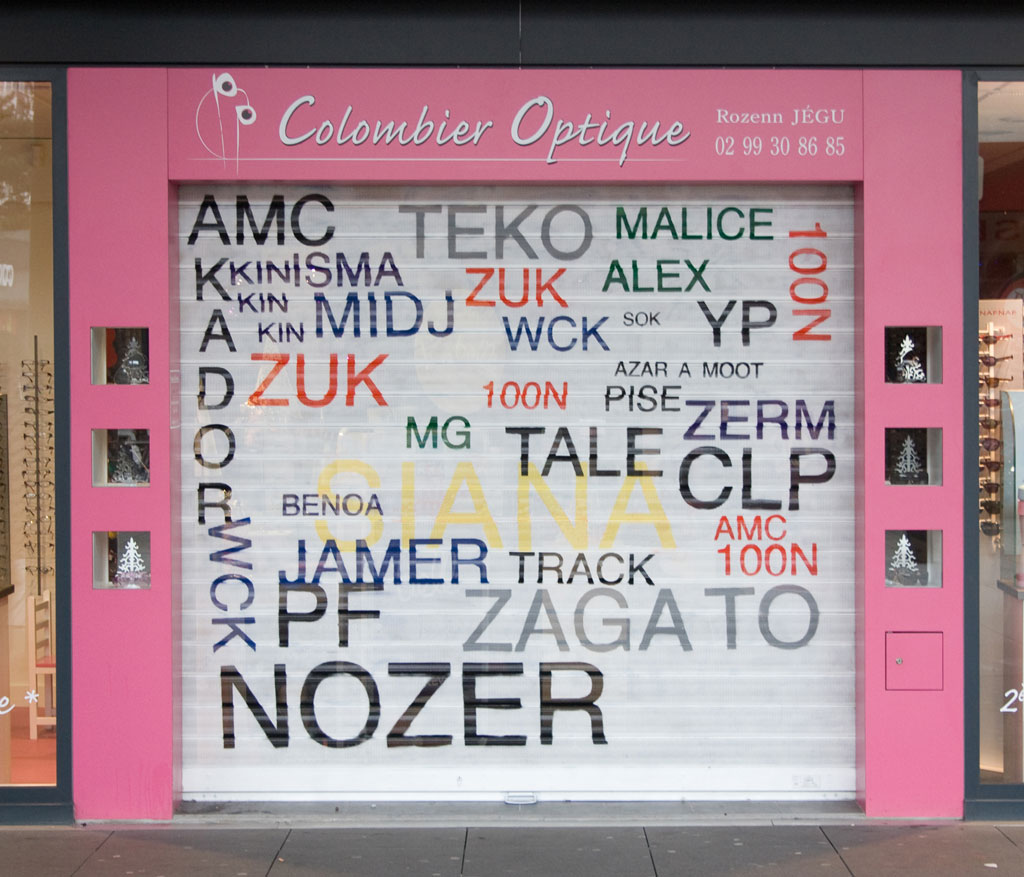
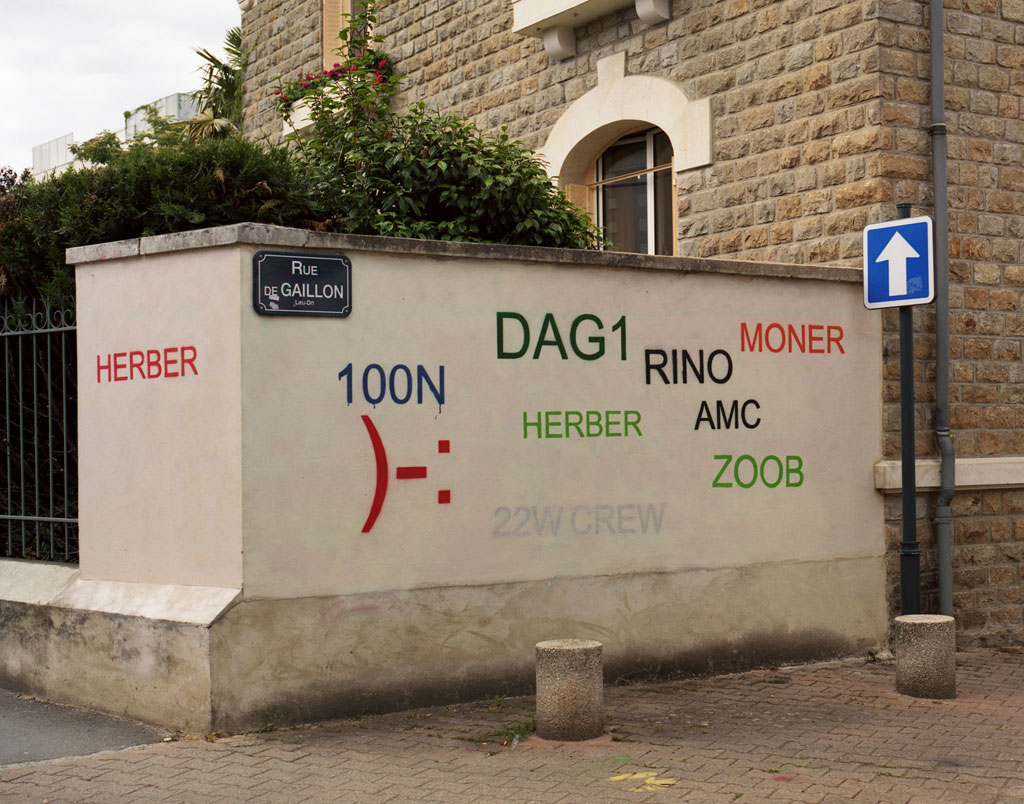
14 years, 3 months ago
On one hand, it could create a new interest for people by trying to read the shape of signatures for themselves and not for a supposed hidden sense. I wonder people could perhaps discover the pleasure of certain complex calligraphy created by writers - because I'm originally a graffiti writer who is still mostly interested by this singular aspect of graffiti.
On the other hand, staying closed to the original composition is a way to refuse the decoration aspect of graffiti mural which is often invited by the owner to cover original signatures all-overs. Shaping it closer to a virtual tag clouds would have been a disrespect the writer original intention which is not to make the wall beautifull.
I made several other tag clouds (which are not shown here) and the final form always depends of the experience of writers but sometimes looks more closer to virtual tag clouds with variation of dimensions. In CSS langage this variation is totally customisable, there's no default scale between words size that could define a standard of tag clouds - it's more the cloud composition which make sense.
The project works around the idea of "reversible coherence", I didn't want to turn reality marks into virtual marks, I only wanted to make people realise that if they understand global meaning and utility of virtual tag, they also could understand the point of real ones.
Finally, the subversion of graffiti writing appears directly in the spelling distortion of common sense words, which could not be confused with commercial communication, even if the project is playing with its codes of readability.